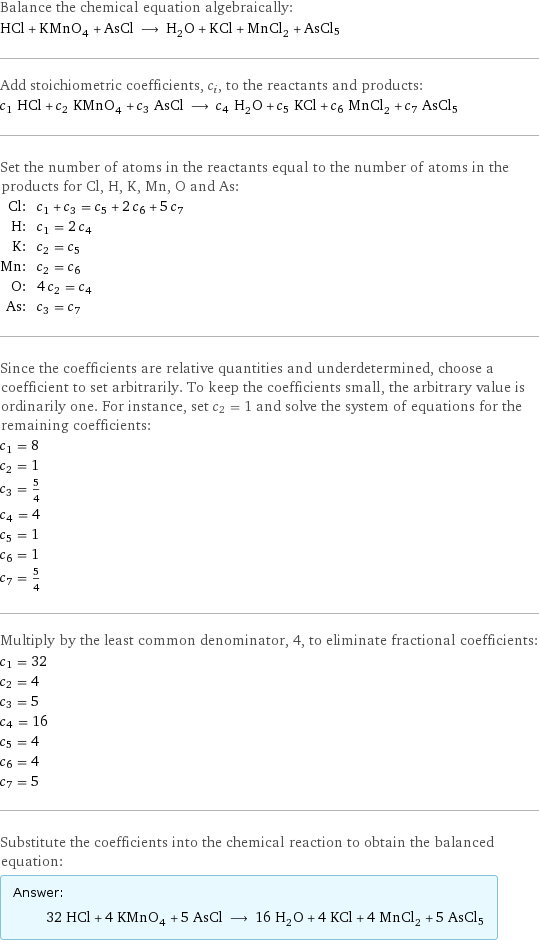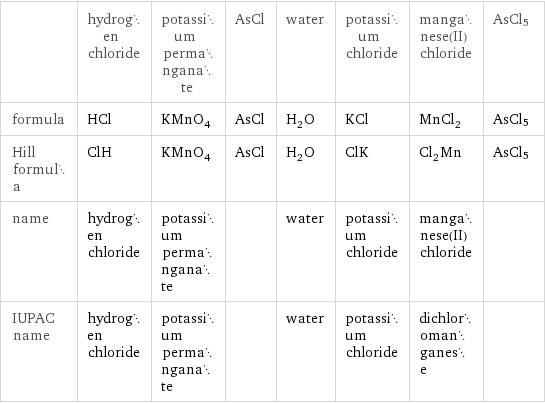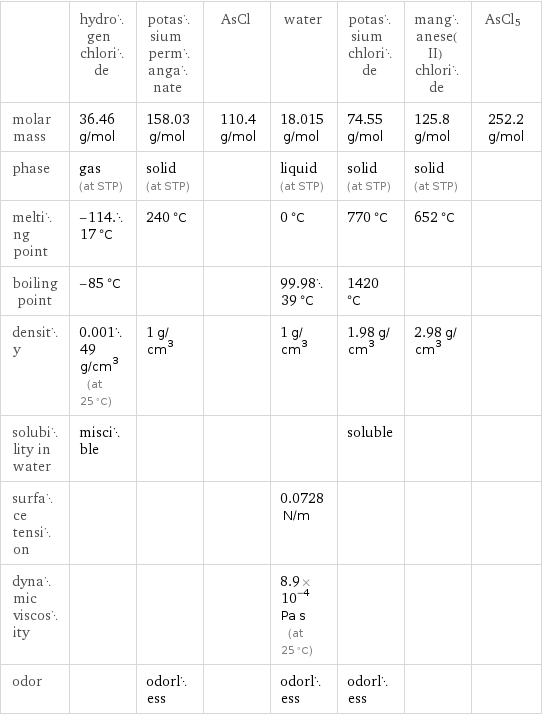Input interpretation

HCl hydrogen chloride + KMnO_4 potassium permanganate + AsCl ⟶ H_2O water + KCl potassium chloride + MnCl_2 manganese(II) chloride + AsCl5
Balanced equation

Balance the chemical equation algebraically: HCl + KMnO_4 + AsCl ⟶ H_2O + KCl + MnCl_2 + AsCl5 Add stoichiometric coefficients, c_i, to the reactants and products: c_1 HCl + c_2 KMnO_4 + c_3 AsCl ⟶ c_4 H_2O + c_5 KCl + c_6 MnCl_2 + c_7 AsCl5 Set the number of atoms in the reactants equal to the number of atoms in the products for Cl, H, K, Mn, O and As: Cl: | c_1 + c_3 = c_5 + 2 c_6 + 5 c_7 H: | c_1 = 2 c_4 K: | c_2 = c_5 Mn: | c_2 = c_6 O: | 4 c_2 = c_4 As: | c_3 = c_7 Since the coefficients are relative quantities and underdetermined, choose a coefficient to set arbitrarily. To keep the coefficients small, the arbitrary value is ordinarily one. For instance, set c_2 = 1 and solve the system of equations for the remaining coefficients: c_1 = 8 c_2 = 1 c_3 = 5/4 c_4 = 4 c_5 = 1 c_6 = 1 c_7 = 5/4 Multiply by the least common denominator, 4, to eliminate fractional coefficients: c_1 = 32 c_2 = 4 c_3 = 5 c_4 = 16 c_5 = 4 c_6 = 4 c_7 = 5 Substitute the coefficients into the chemical reaction to obtain the balanced equation: Answer: | | 32 HCl + 4 KMnO_4 + 5 AsCl ⟶ 16 H_2O + 4 KCl + 4 MnCl_2 + 5 AsCl5
Structures

+ + AsCl ⟶ + + + AsCl5
Names

hydrogen chloride + potassium permanganate + AsCl ⟶ water + potassium chloride + manganese(II) chloride + AsCl5
Equilibrium constant
![Construct the equilibrium constant, K, expression for: HCl + KMnO_4 + AsCl ⟶ H_2O + KCl + MnCl_2 + AsCl5 Plan: • Balance the chemical equation. • Determine the stoichiometric numbers. • Assemble the activity expression for each chemical species. • Use the activity expressions to build the equilibrium constant expression. Write the balanced chemical equation: 32 HCl + 4 KMnO_4 + 5 AsCl ⟶ 16 H_2O + 4 KCl + 4 MnCl_2 + 5 AsCl5 Assign stoichiometric numbers, ν_i, using the stoichiometric coefficients, c_i, from the balanced chemical equation in the following manner: ν_i = -c_i for reactants and ν_i = c_i for products: chemical species | c_i | ν_i HCl | 32 | -32 KMnO_4 | 4 | -4 AsCl | 5 | -5 H_2O | 16 | 16 KCl | 4 | 4 MnCl_2 | 4 | 4 AsCl5 | 5 | 5 Assemble the activity expressions accounting for the state of matter and ν_i: chemical species | c_i | ν_i | activity expression HCl | 32 | -32 | ([HCl])^(-32) KMnO_4 | 4 | -4 | ([KMnO4])^(-4) AsCl | 5 | -5 | ([AsCl])^(-5) H_2O | 16 | 16 | ([H2O])^16 KCl | 4 | 4 | ([KCl])^4 MnCl_2 | 4 | 4 | ([MnCl2])^4 AsCl5 | 5 | 5 | ([AsCl5])^5 The equilibrium constant symbol in the concentration basis is: K_c Mulitply the activity expressions to arrive at the K_c expression: Answer: | | K_c = ([HCl])^(-32) ([KMnO4])^(-4) ([AsCl])^(-5) ([H2O])^16 ([KCl])^4 ([MnCl2])^4 ([AsCl5])^5 = (([H2O])^16 ([KCl])^4 ([MnCl2])^4 ([AsCl5])^5)/(([HCl])^32 ([KMnO4])^4 ([AsCl])^5)](../image_source/51207040c0feff73a1d8ebfc3822d648.png)
Construct the equilibrium constant, K, expression for: HCl + KMnO_4 + AsCl ⟶ H_2O + KCl + MnCl_2 + AsCl5 Plan: • Balance the chemical equation. • Determine the stoichiometric numbers. • Assemble the activity expression for each chemical species. • Use the activity expressions to build the equilibrium constant expression. Write the balanced chemical equation: 32 HCl + 4 KMnO_4 + 5 AsCl ⟶ 16 H_2O + 4 KCl + 4 MnCl_2 + 5 AsCl5 Assign stoichiometric numbers, ν_i, using the stoichiometric coefficients, c_i, from the balanced chemical equation in the following manner: ν_i = -c_i for reactants and ν_i = c_i for products: chemical species | c_i | ν_i HCl | 32 | -32 KMnO_4 | 4 | -4 AsCl | 5 | -5 H_2O | 16 | 16 KCl | 4 | 4 MnCl_2 | 4 | 4 AsCl5 | 5 | 5 Assemble the activity expressions accounting for the state of matter and ν_i: chemical species | c_i | ν_i | activity expression HCl | 32 | -32 | ([HCl])^(-32) KMnO_4 | 4 | -4 | ([KMnO4])^(-4) AsCl | 5 | -5 | ([AsCl])^(-5) H_2O | 16 | 16 | ([H2O])^16 KCl | 4 | 4 | ([KCl])^4 MnCl_2 | 4 | 4 | ([MnCl2])^4 AsCl5 | 5 | 5 | ([AsCl5])^5 The equilibrium constant symbol in the concentration basis is: K_c Mulitply the activity expressions to arrive at the K_c expression: Answer: | | K_c = ([HCl])^(-32) ([KMnO4])^(-4) ([AsCl])^(-5) ([H2O])^16 ([KCl])^4 ([MnCl2])^4 ([AsCl5])^5 = (([H2O])^16 ([KCl])^4 ([MnCl2])^4 ([AsCl5])^5)/(([HCl])^32 ([KMnO4])^4 ([AsCl])^5)
Rate of reaction
![Construct the rate of reaction expression for: HCl + KMnO_4 + AsCl ⟶ H_2O + KCl + MnCl_2 + AsCl5 Plan: • Balance the chemical equation. • Determine the stoichiometric numbers. • Assemble the rate term for each chemical species. • Write the rate of reaction expression. Write the balanced chemical equation: 32 HCl + 4 KMnO_4 + 5 AsCl ⟶ 16 H_2O + 4 KCl + 4 MnCl_2 + 5 AsCl5 Assign stoichiometric numbers, ν_i, using the stoichiometric coefficients, c_i, from the balanced chemical equation in the following manner: ν_i = -c_i for reactants and ν_i = c_i for products: chemical species | c_i | ν_i HCl | 32 | -32 KMnO_4 | 4 | -4 AsCl | 5 | -5 H_2O | 16 | 16 KCl | 4 | 4 MnCl_2 | 4 | 4 AsCl5 | 5 | 5 The rate term for each chemical species, B_i, is 1/ν_i(Δ[B_i])/(Δt) where [B_i] is the amount concentration and t is time: chemical species | c_i | ν_i | rate term HCl | 32 | -32 | -1/32 (Δ[HCl])/(Δt) KMnO_4 | 4 | -4 | -1/4 (Δ[KMnO4])/(Δt) AsCl | 5 | -5 | -1/5 (Δ[AsCl])/(Δt) H_2O | 16 | 16 | 1/16 (Δ[H2O])/(Δt) KCl | 4 | 4 | 1/4 (Δ[KCl])/(Δt) MnCl_2 | 4 | 4 | 1/4 (Δ[MnCl2])/(Δt) AsCl5 | 5 | 5 | 1/5 (Δ[AsCl5])/(Δt) (for infinitesimal rate of change, replace Δ with d) Set the rate terms equal to each other to arrive at the rate expression: Answer: | | rate = -1/32 (Δ[HCl])/(Δt) = -1/4 (Δ[KMnO4])/(Δt) = -1/5 (Δ[AsCl])/(Δt) = 1/16 (Δ[H2O])/(Δt) = 1/4 (Δ[KCl])/(Δt) = 1/4 (Δ[MnCl2])/(Δt) = 1/5 (Δ[AsCl5])/(Δt) (assuming constant volume and no accumulation of intermediates or side products)](../image_source/a7fc519fcc305fee993312a3903aacf5.png)
Construct the rate of reaction expression for: HCl + KMnO_4 + AsCl ⟶ H_2O + KCl + MnCl_2 + AsCl5 Plan: • Balance the chemical equation. • Determine the stoichiometric numbers. • Assemble the rate term for each chemical species. • Write the rate of reaction expression. Write the balanced chemical equation: 32 HCl + 4 KMnO_4 + 5 AsCl ⟶ 16 H_2O + 4 KCl + 4 MnCl_2 + 5 AsCl5 Assign stoichiometric numbers, ν_i, using the stoichiometric coefficients, c_i, from the balanced chemical equation in the following manner: ν_i = -c_i for reactants and ν_i = c_i for products: chemical species | c_i | ν_i HCl | 32 | -32 KMnO_4 | 4 | -4 AsCl | 5 | -5 H_2O | 16 | 16 KCl | 4 | 4 MnCl_2 | 4 | 4 AsCl5 | 5 | 5 The rate term for each chemical species, B_i, is 1/ν_i(Δ[B_i])/(Δt) where [B_i] is the amount concentration and t is time: chemical species | c_i | ν_i | rate term HCl | 32 | -32 | -1/32 (Δ[HCl])/(Δt) KMnO_4 | 4 | -4 | -1/4 (Δ[KMnO4])/(Δt) AsCl | 5 | -5 | -1/5 (Δ[AsCl])/(Δt) H_2O | 16 | 16 | 1/16 (Δ[H2O])/(Δt) KCl | 4 | 4 | 1/4 (Δ[KCl])/(Δt) MnCl_2 | 4 | 4 | 1/4 (Δ[MnCl2])/(Δt) AsCl5 | 5 | 5 | 1/5 (Δ[AsCl5])/(Δt) (for infinitesimal rate of change, replace Δ with d) Set the rate terms equal to each other to arrive at the rate expression: Answer: | | rate = -1/32 (Δ[HCl])/(Δt) = -1/4 (Δ[KMnO4])/(Δt) = -1/5 (Δ[AsCl])/(Δt) = 1/16 (Δ[H2O])/(Δt) = 1/4 (Δ[KCl])/(Δt) = 1/4 (Δ[MnCl2])/(Δt) = 1/5 (Δ[AsCl5])/(Δt) (assuming constant volume and no accumulation of intermediates or side products)
Chemical names and formulas

| hydrogen chloride | potassium permanganate | AsCl | water | potassium chloride | manganese(II) chloride | AsCl5 formula | HCl | KMnO_4 | AsCl | H_2O | KCl | MnCl_2 | AsCl5 Hill formula | ClH | KMnO_4 | AsCl | H_2O | ClK | Cl_2Mn | AsCl5 name | hydrogen chloride | potassium permanganate | | water | potassium chloride | manganese(II) chloride | IUPAC name | hydrogen chloride | potassium permanganate | | water | potassium chloride | dichloromanganese |
Substance properties

| hydrogen chloride | potassium permanganate | AsCl | water | potassium chloride | manganese(II) chloride | AsCl5 molar mass | 36.46 g/mol | 158.03 g/mol | 110.4 g/mol | 18.015 g/mol | 74.55 g/mol | 125.8 g/mol | 252.2 g/mol phase | gas (at STP) | solid (at STP) | | liquid (at STP) | solid (at STP) | solid (at STP) | melting point | -114.17 °C | 240 °C | | 0 °C | 770 °C | 652 °C | boiling point | -85 °C | | | 99.9839 °C | 1420 °C | | density | 0.00149 g/cm^3 (at 25 °C) | 1 g/cm^3 | | 1 g/cm^3 | 1.98 g/cm^3 | 2.98 g/cm^3 | solubility in water | miscible | | | | soluble | | surface tension | | | | 0.0728 N/m | | | dynamic viscosity | | | | 8.9×10^-4 Pa s (at 25 °C) | | | odor | | odorless | | odorless | odorless | |
Units
